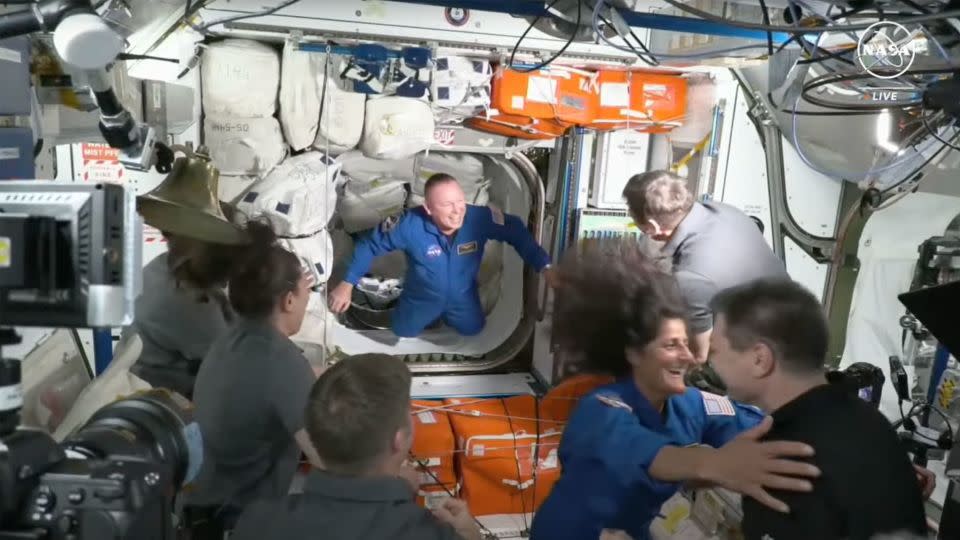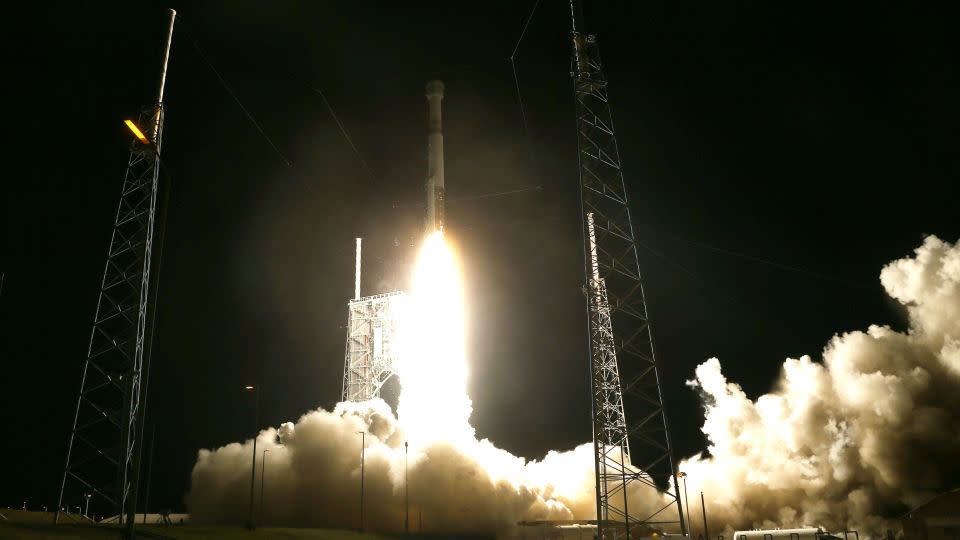Sign up for CNN’s Wonder Theory science newsletter. Explore the universe with news about fascinating discoveries, scientific advances and more.
The SpaceX Crew Dragon capsule will bring home two NASA astronauts who have been stuck at the International Space Station for nearly 80 days due to problems with their Boeing Starliner spacecraft, in a surprising development for the struggling aerospace giant.
The news comes after the space agency conducted a formal review on Saturday to determine whether Boeing’s Starliner vehicle is safe enough to return home with its crew, or whether SpaceX’s workhorse Crew Dragon spacecraft will need to step in to save the day.
The Starliner vehicle that carried astronauts Suni Williams and Butch Wilmore to the space station in early June has been plagued by helium leaks and thrusters that suddenly stopped working during the first leg of its first crewed test flight. Engineers spent weeks better understanding the problems, and Boeing said it had “high confidence” that the spacecraft could return Williams and Wilmore to Earth as early as Aug. 2.

NASA announced at a press conference on Aug. 7 that discussions are progressing within the space agency about the safety of the Starliner capsule. That has led the federal agency to more seriously consider the idea of flying astronauts home on the SpaceX Crew Dragon vehicle, which has flown about a dozen crewed missions into space since 2020.
On Saturday, NASA Administrator Bill Nelson said NASA considered its extensive experience with spaceflight — both successful and unsuccessful — in making the decision. A survey of NASA representatives across the agency’s departments and research, control and development centers resulted in a unanimous decision, according to agency officials.
“We’ve made mistakes in the past: We’ve lost two space shuttles as a result of not having a culture where information can come out,” Nelson said. “Space flight is risky, even at its safest and most routine. And a test flight is inherently neither safe nor routine.”
SpaceX plans to conduct a routine mission to the International Space Station carrying four astronauts as part of standard crew rotations aboard the orbiting laboratory, but the mission, called Crew-9, will now be reconfigured to carry two astronauts instead of four.
This adjustment will leave two empty seats for Williams and Wilmore to occupy on the Crew-9 flight home. The astronauts will also join the Crew-9 crew and become part of the official ISS expedition. With this transition, Williams and Wilmore will remain on site for another six months, the length of a routine mission to the space station.
With the assignment to Crew-9, the duo’s return will be postponed until February 2025 at the earliest.
Starliner will return home empty in early September, NASA said Saturday.
If the uncrewed return trip goes well, NASA will face a critical decision: whether to officially certify Starliner for human spaceflight, a step that would allow the vehicle to make routine trips to orbit even if it didn’t complete its mission as planned.
No representatives from Boeing attended Saturday’s press conference.
“We remain focused on the safety of the crew and spacecraft first and foremost. We are executing the mission as outlined by NASA and preparing the spacecraft for a safe and successful uncrewed return,” Boeing said in a statement on Saturday.
“There is only a small disagreement (between NASA and Boeing) on the level of risk,” Steve Stich, NASA Commercial Crew Program manager, said Saturday.
“It just depends on how you evaluate risk,” Stich said. “We did it a little differently with our crew than Boeing did.”
Nelson later added that he was “100%” confident Boeing would fix the issues and prepare Starliner for another crewed mission at some point in the future.
SpaceX’s chief operating officer, Gwynne Shotwell, also responded to the news with a post on the social media platform X, formerly known as Twitter.
“SpaceX stands ready to provide all the support we can to @NASA,” said Shotwell.
Faulty thrusters
Five of the Starliner’s 28 “reaction control thrusters” stopped working during the first leg of Boeing’s test mission. All but one were eventually recovered.
Although Williams and Wilmore planned to spend only eight days in space, their stay at the orbiting laboratory was extended by nearly two months as engineers on the ground worked to better understand thruster problems.
Officials said ground tests were able to recreate how the thrusters would deteriorate in space during flight. Boeing said the likely root cause is heat buildup inside the thrusters, which could have caused the seals to swell and restrict propellant flow.
Problems with helium leaks could be the result of seals failing due to exposure to fuel vapor, according to comments on July 25 by Mark Nappi, Boeing Commercial Crew Program manager.
But NASA initially struggled to reach a consensus on how these issues would affect astronauts’ return from space and how much of a risk they would pose.
Stich said Saturday that uncertainty about the level of risk led the agency to turn to SpaceX and its cargo ship Crew Dragon.
“The main issue with bringing Starliner back was that there was too much uncertainty in the prediction of the thrusters,” he said. “There was too much risk with a crew, and so we decided to go the uncrewed route.”
Starliner’s bumpy road
NASA has repeatedly said that SpaceX’s ability to intervene demonstrates how the space agency deliberately designed the Commercial Crew Program, under which both Starliner and Crew Dragon are being developed, to allow each spacecraft to serve as a backup for the other.
“We’re in a new situation here, and we have multiple options,” Ken Bowersox of NASA’s Space Operations Mission Directorate said Aug. 7. “This is something we’ll have to deal with in the future — we may find ourselves in a situation where we have to bring a (SpaceX) Dragon crew or a (Russian) Soyuz crew back to a Starliner.
“That’s why we want more than one vehicle so we have that option,” Bowersox added.
Yet the federal agency simultaneously funded SpaceX’s Crew Dragon and Boeing’s Starliner projects in 2014. Although Crew Dragon has been in operation for four years, the Starliner program is hundreds of millions of dollars over budget and years behind schedule.
Boeing’s development process is also riddled with errors.
For example, the first Starliner test mission, flown without a crew in 2019, failed in orbit, leaving the flight far behind expectations. The vehicle ultimately failed to dock with the space station as planned, a symptom of numerous software issues, including a coding error that moved an internal clock forward by 11 hours.


A second uncrewed flight test in May 2022 revealed additional software issues, and mission teams addressed issues with some of the vehicle’s thrusters. However, the root cause of the thruster issue affecting this crewed mission was overlooked two years ago.
Whether the Starliner vehicle will ultimately be certified after it returns to Earth is likely to be a contentious issue, and is considered the most dangerous leg of the mission. The autonomous vehicle will have to use its thrusters to precisely guide itself as it plunges back into Earth’s thick atmosphere. The pressure and friction are expected to heat the vehicle’s exterior to around 3,000 degrees Fahrenheit (1,650 degrees Celsius).
Starliner’s parachutes must deploy smoothly and slow the spacecraft down enough for the airbags to deploy and soften the landing.
If the Starliner capsule is eventually certified, it could join SpaceX’s Crew Dragon in rotating crews on routine trips to the space station, which currently occur about every six months.
Weighing the costs
But if the spacecraft is not certified, it would be another blow to Boeing’s already badly damaged reputation. Missing the target could cost the company millions of dollars — on top of the roughly $1.5 billion in losses it has already recorded on the Starliner program.
“We all wanted to complete the (Boeing Starliner) test flight with a crew, and I think we were all disappointed that we didn’t get to do that,” Bowersox said Saturday. But “you don’t want that disappointment to weigh unhealthily on your decision.”
Boeing’s cost overruns have repeatedly fueled rumors that Boeing will not be able to complete the Starliner program.
Nelson said Saturday that he recently spoke with Boeing’s new CEO Kelly Ortberg about the Starliner status.
“I told him how well Boeing worked with our team to come to this decision, and he assured me that once Starliner is safely back, they will continue to work on the issues and ensure we have redundancy and crewed access to the space station,” Nelson said.
However, it is not yet clear who will cover the additional testing and development costs that may be needed for Starliner development to reach the finish line.
Nelson reiterated Saturday that his deal with Boeing is a “fixed-price contract,” meaning it is designed as a single lump sum payment and payments do not increase with delays as they would in alternative contracts such as “cost-plus.”
But Nelson added that discussions about how much Boeing was willing to pay for additional testing were not part of his conversation with the CEO.
“I don’t know the answer to that question and I don’t think we will ever have an answer,” Nelson said.
For more CNN news and bulletins, create an account at CNN.com